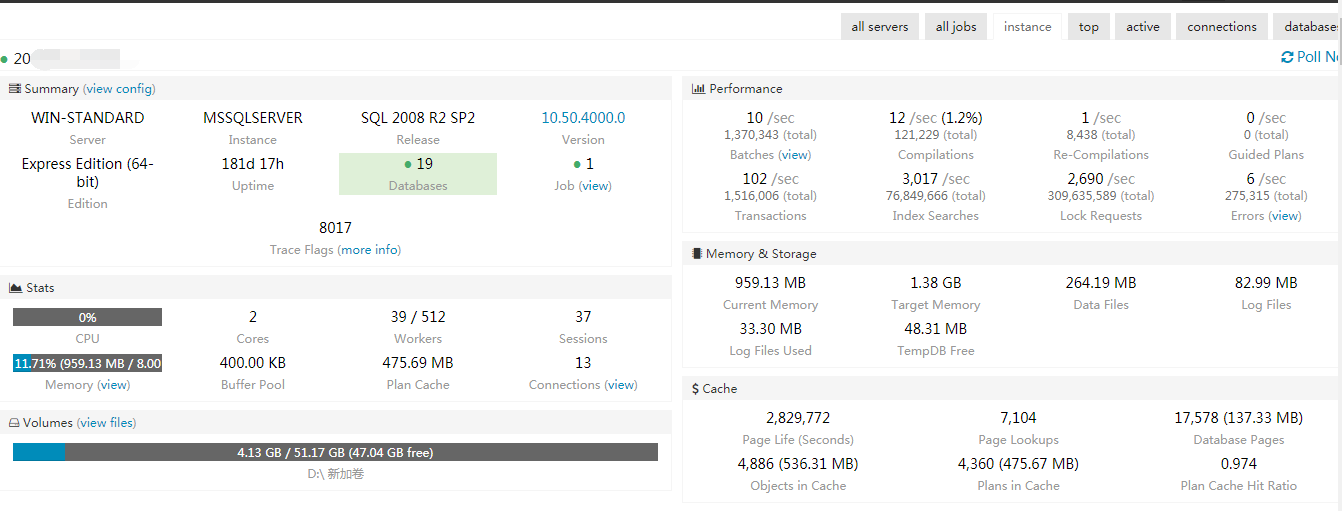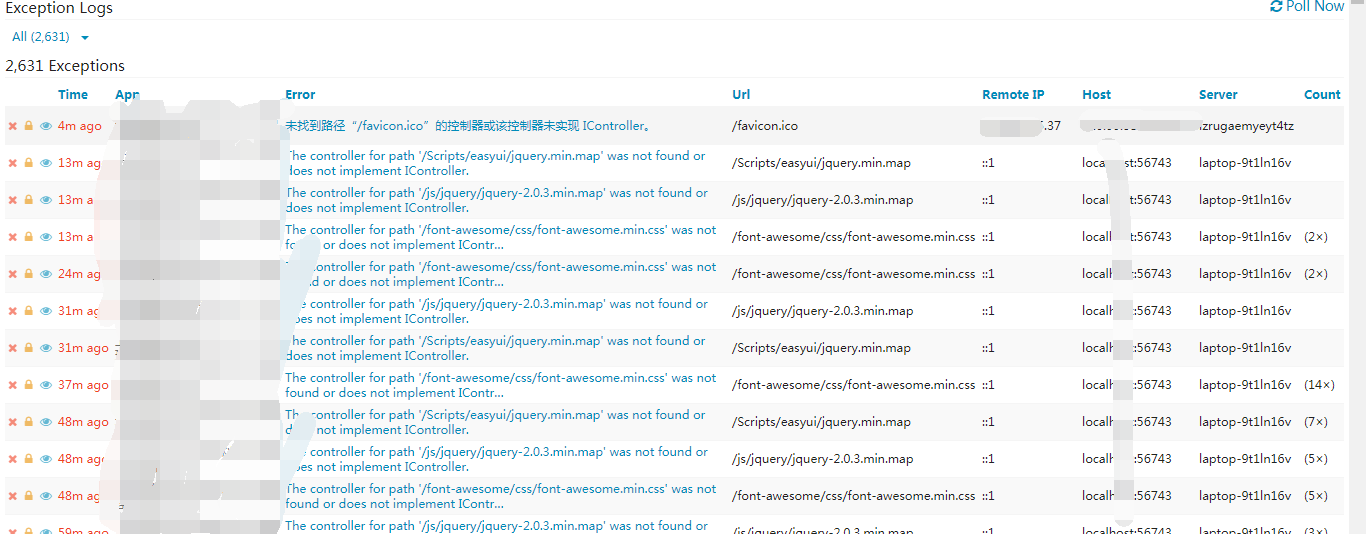采用Opserver来监控你的ASP.NET项目系列(二、监控SQL Server与Asp.Net项目)
前言
之前有过2篇关于如何监控ASP.NET core项目的文章,有兴趣的也可以看看.
今天我们主要来介绍一下,如何使用Opserver监控我们的SQL Server 和ASP.NET项目的异常监控
监控效果如下:
SQL Server的:


ASP.NET异常情况的监控:

监控SQL Server
首先我们来讲解一下如何监控我们的SQL Server.
上篇内容我们已经提到过 Opeserver的项目有很多的配置文件.
我们找到我们的SQLSettings.example.json文件,改名为SQLSettings.json文件
修改其中的配置项如下:
/* Configuration for the SQL Server dashboard */ { "defaultConnectionString": "", "refreshIntervalSeconds": 30, "clusters": [ { "name": "192.168.1.120", "refreshIntervalSeconds": 20, "nodes": [ { "name": "192.168.1.121" }, { "name": "192.168.1.122" }, { "name": "192.168.1.123" } ] } ], "instances": [ { "name": "实例名称", "connectionString": "数据库连接字符串", "refreshIntervalSeconds": 200 } ] }
解释一下其中的意义,参照如下:
defaultConnectionString (默认的连接字符串,用于单台数据库监控)
refreshIntervalSeconds (轮询数据库情况的刷新时间,如果不设置,默认为60秒)
instances (当有多台单独的数据库实例需要监控时候的数据库实例设置)
clusters (当你的数据库是集群部署的时候的设置)
后面的内容都一样,我就不一一解释了,多台数据库实例,可以自行在instances 中添加多个节点,集群就在clusters中加入节点地址即可
然后,我们直接运行OpSever项目,就可以观察到数据库的变化情况了.
监控ASP.NET项目的异常情况
下面我们来讲讲如何监控我们的ASP.NET项目异常的情况
1.我们需要在在web项目中通过nuget安装StackExchange.Exceptional组件(它依赖于dapper)
2.在web.config中的configSections节点下增加section节点 “Exceptional”,如下:
<configSections> <section name="Exceptional" type="StackExchange.Exceptional.Settings" /> </configSections>
3.在web.config中增加Exceptional节点,如下:
<Exceptional applicationName="应用名称"> <!--<ErrorStore type="Memory" />--> <!--连接opserver数据库时开启--> <ErrorStore type="存储类型" connectionString="连接字符串" /> </Exceptional>
ErrorStore 错误存储有4种实现方式,Memory,JSON,SQL,MySQL,如下是官方的说明译文:
<!--如果没有设置ErrorStore,将默认使用内存的形式来记录错误--> <!--<ErrorStore type="Memory" />--> <!-- 其他的存储类型, 相关的设置属性如下: - rollupSeconds:页面上异常的更新秒数,默认为600秒 - backupQueueSize: 设置缓存多少错误,默认为1000条--> <!-- JSON:Size是设置Json存储的文件数量,默认为200--> <!--<ErrorStore type="JSON" path="~/Errors" size="200" />--> <!-- SQL: 只需要设置数据库连接字符串如下: --> <!--<ErrorStore type="SQL" connectionString="Server=.;Database=Exceptions;Uid=Exceptions;Pwd=myPassword!" />--> <!--<ErrorStore type="SQL" connectionStringName="MyConnectionString" />--> <!--你也可以设置为Mysql如下 --> <!--<ErrorStore type="MySQL" connectionString="Server=.;Database=Exceptions;Username=Exceptions;Pwd=myPassword!" />--> <!--<ErrorStore type="MySQL" connectionStringName="MyConnectionString" />-->
这里我们采用SQL的形式,直接存在数据库里.
4.修改web.config的system.webServer节点,添加新的handlers,modules配置如下:
<system.webServer>
<validation validateIntegratedModeConfiguration="false" />
<handlers> <add name="Exceptional" path="exceptions.axd" verb="POST,GET,HEAD" type="StackExchange.Exceptional.HandlerFactory, StackExchange.Exceptional" preCondition="integratedMode" /> </handlers> <modules> <add name="ErrorLog" type="StackExchange.Exceptional.ExceptionalModule, StackExchange.Exceptional" /> </modules> </system.webServer>
5.因为我这里采用的SQL存储,所以需要给数据库添加存储错误信息的表,SQL语句如下:
USE [OpServerTest] GO /****** Object: Table [dbo].[Exceptions] Script Date: 2016/11/16 16:28:56 ******/ SET ANSI_NULLS ON GO SET QUOTED_IDENTIFIER ON GO SET ANSI_PADDING ON GO CREATE TABLE [dbo].[Exceptions]( [Id] [bigint] IDENTITY(1,1) NOT NULL, [GUID] [uniqueidentifier] NOT NULL, [ApplicationName] [nvarchar](50) NOT NULL, [MachineName] [nvarchar](50) NOT NULL, [CreationDate] [datetime] NOT NULL, [Type] [nvarchar](100) NOT NULL, [IsProtected] [bit] NOT NULL, [Host] [nvarchar](100) NULL, [Url] [nvarchar](500) NULL, [HTTPMethod] [nvarchar](10) NULL, [IPAddress] [varchar](40) NULL, [Source] [nvarchar](100) NULL, [Message] [nvarchar](1000) NULL, [Detail] [nvarchar](max) NULL, [StatusCode] [int] NULL, [SQL] [nvarchar](max) NULL, [DeletionDate] [datetime] NULL, [FullJson] [nvarchar](max) NULL, [ErrorHash] [int] NULL, [DuplicateCount] [int] NOT NULL, CONSTRAINT [PK_Exceptions] PRIMARY KEY CLUSTERED ( [Id] ASC )WITH (PAD_INDEX = OFF, STATISTICS_NORECOMPUTE = OFF, IGNORE_DUP_KEY = OFF, ALLOW_ROW_LOCKS = ON, ALLOW_PAGE_LOCKS = ON) ON [PRIMARY] ) ON [PRIMARY] TEXTIMAGE_ON [PRIMARY] GO SET ANSI_PADDING OFF GO ALTER TABLE [dbo].[Exceptions] ADD DEFAULT ((0)) FOR [IsProtected] GO ALTER TABLE [dbo].[Exceptions] ADD DEFAULT ((1)) FOR [DuplicateCount] GO
6.最后回到OpServer项目修改ExceptionsSettings.example.json文件为ExceptionsSettings.json,并添加配置如下:
{ "stores": [ //异常日志存储位置
{
"name": "ExceptionDB",
"queryTimeoutMs": 2000,
"pollIntervalSeconds": 10,
"connectionString": "错误存储的地址"
}
]
}
7.想增加自定义的错误信息,可以编写如下代码:
try { throw new Exception("Just a try/catch test"); } catch (Exception ex) { // logged, but caught so we don't crash ErrorStore.LogExceptionWithoutContext(ex); }
这样,异常也会记录到存储里面去了.
写在最后
本篇到此结束,下篇介绍如何监控我们的服务器状态
作者:顾振印
出处:http://www.cnblogs.com/GuZhenYin/
如果您觉得阅读本文对您有帮助,请点一下“推荐”按钮,您的“推荐”将是我最大的写作动力!本文版权归作者和博客园共有,欢迎转载,但未经作者同意必须保留此段声明,且在文章页面

 浙公网安备 33010602011771号
浙公网安备 33010602011771号